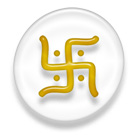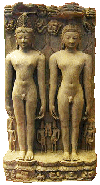Jainism

Introduction
Jainism is an ancient religion from India promoting non-violence, for all beings in the universe, as the only acceptable means of experiencing life. Basically, it’s a constant attempt for the soul ascending onward to reach an apex of spirituality. When a soul has reached Jina, the most enlightened state, it means that all of the inner demons have been exorcised, and an inner equilibrium is reached.
Spirituality
Some of the major spiritual points of Jainism are the following: every living creature has a soul; every soul can potentially become divine through knowledge, harmony, and power. Every being should be treated with equal respect, this means hurting no one. Each entity or soul is born human, sub-human, hellish, or celestial, as far as karma is concerned. Each being is the creator of his or her life, in this one or hereafter. The moment a soul has relinquished its karma, only then can divine consciousness, knowledge, infinite perception, and peace become a reality. Jainism focuses a lot on mastering the senses, as they have proven to lead the individual into vice—further from the spiritual self. In addition, owning physical objects and wealth are okay, so long as unhealthy attachment does not take place. By removing one’s self of negative, unenlightened thoughts through what is referred to as clearance or karmic repair, the individual ascends into the divine nature and aligns his or herself with the most enlightened spirits.
Practices
 Some of the current practices regarding Jainism have to do with participating is asceticism. This idea
typically refers to minimizing one’s indulgences, and taking on habits of maintaining one’s health
through diet, no matter how difficult it becomes. Being a vegetarian is essential, for otherwise it
would be aggressive towards animals, which is obviously against their beliefs. Another important aspect
of Jainism has to do with stopping the cycle of transmigration, namely ending one’s ill ways in this
life, so that there won’t be another one afterward. Hopefully, at the end of the life, the individual
will not need to repeat it because the karmic business has been finished. On a daily basis, a typical
Jain worship is a universal prayer, “Namokar Mantra,” and includes symbols offered as reminder of their
path to attain the revered Moksha, or the ultimate liberation.
Some of the current practices regarding Jainism have to do with participating is asceticism. This idea
typically refers to minimizing one’s indulgences, and taking on habits of maintaining one’s health
through diet, no matter how difficult it becomes. Being a vegetarian is essential, for otherwise it
would be aggressive towards animals, which is obviously against their beliefs. Another important aspect
of Jainism has to do with stopping the cycle of transmigration, namely ending one’s ill ways in this
life, so that there won’t be another one afterward. Hopefully, at the end of the life, the individual
will not need to repeat it because the karmic business has been finished. On a daily basis, a typical
Jain worship is a universal prayer, “Namokar Mantra,” and includes symbols offered as reminder of their
path to attain the revered Moksha, or the ultimate liberation.
The Namokar Mantra is as follows:
Namo Arihantânam (I bow to the Arihantâs (Prophets)).Namo Siddhânam (I bow to the Siddhâs (Liberated Souls))
Namo Âyariyânam (I bow to the Âchâryas (Preceptors or Spiritual Leaders)).
Namo Uvajjhâyanam (I bow to the Upadhyâya (Teachers)).
Namo Loe Savva Sahûnam (I bow to all the Sadhûs (Saints)).
Eso Panch Namokkaro, Savva Pâvappanâsano Mangalanam Cha Savvesim, Padhamam Havai Mangalam (This fivefold bow destroys all sins and obstacles and of all auspicious mantras, is the first and foremost one).

